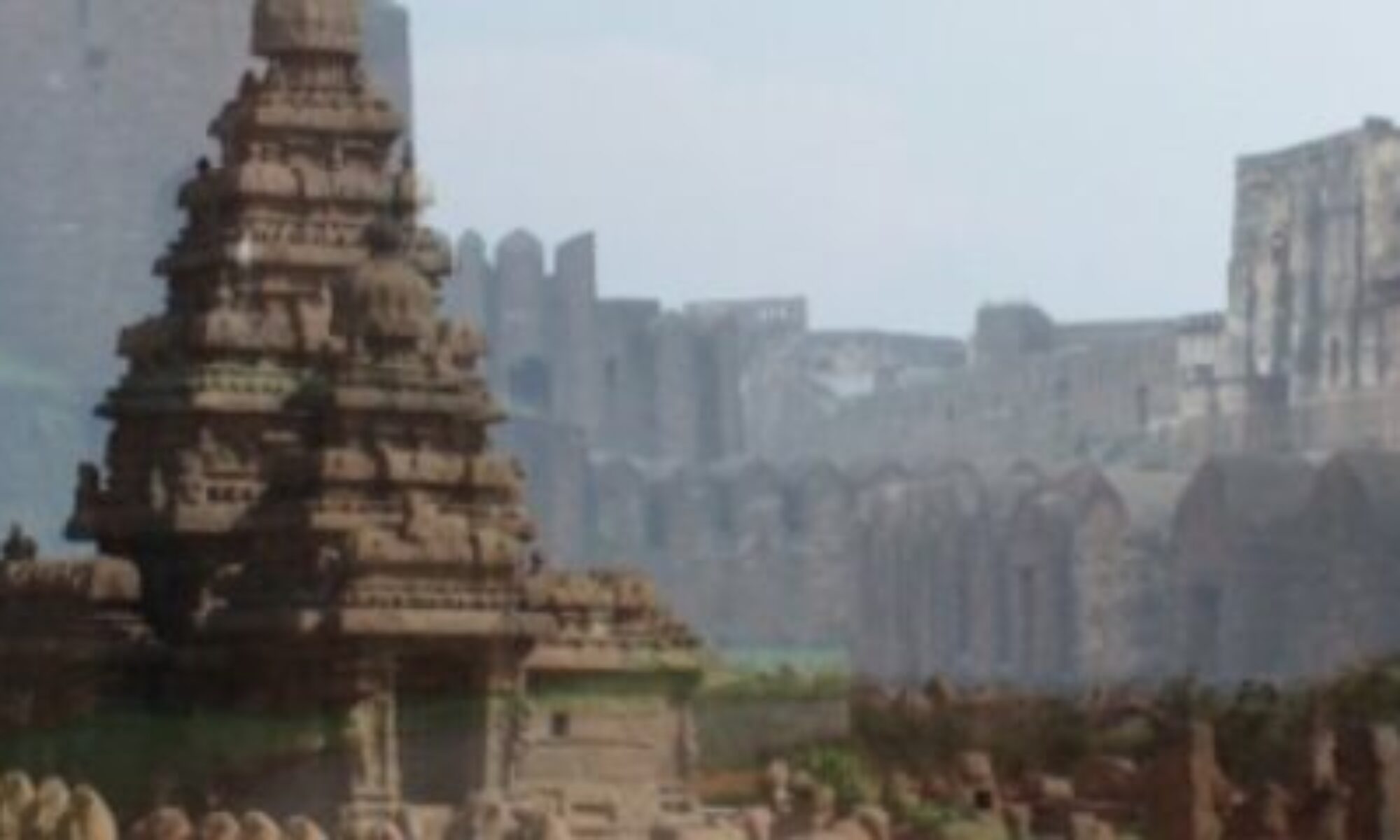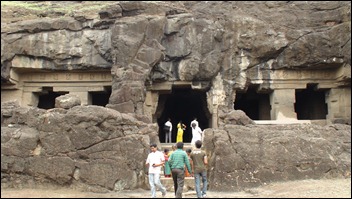 The next large cave north of Kailasa, Cave 17 is across a deep ravine, and till 1876 was filled to a depth of 6 or 7 feet with earth, so that only the capitals of the pillars are visible. It was, however, worth excavating, and has been cleaned with care, and without damage to the carvings.
The next large cave north of Kailasa, Cave 17 is across a deep ravine, and till 1876 was filled to a depth of 6 or 7 feet with earth, so that only the capitals of the pillars are visible. It was, however, worth excavating, and has been cleaned with care, and without damage to the carvings. 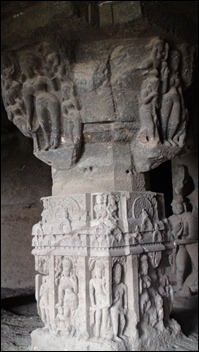
This is a Saiva temple with three rows of four pillars from side to side; the front and the back aisles being 64 feet long and the depth till the front of the shrine is 37 feet, or all over 76 feet. In front has been a porch raised by 7 or 8 steps above the level of the court, on two massive square pillars, one of which is gone and the other reduced to a shapeless mass principally by the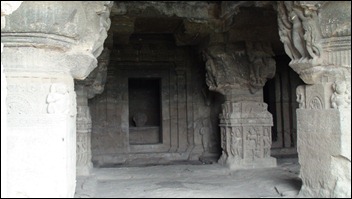 weather. Surrounding the court on three sides has been a low covered corridor with a small door in the center for ingress. Over this corridor is a sculpted compartment on either side dedicated to Brahma and Vishnu.
weather. Surrounding the court on three sides has been a low covered corridor with a small door in the center for ingress. Over this corridor is a sculpted compartment on either side dedicated to Brahma and Vishnu.
The extreme pillars of the front are plain square ones with bracket capitals; the inner pair have deep brackets and carved with female figures and dwarf attendants. The middle pair in the next row have cushi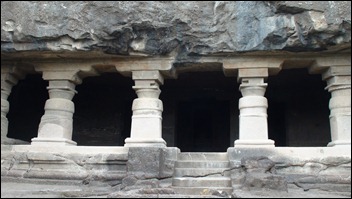 on capitals with female figures. The middle pillars of the next row are unlike any others, the base is of the broken square pattern with female figures carved on the principal faces and males on the corner ones. Over this is a Dravidian molding as in the pilasters of Ravan-Ki-Kai, then a belt of floral ornament in the center, and two dwarfs at the corner. These columns are too heavy to be elegant.
on capitals with female figures. The middle pillars of the next row are unlike any others, the base is of the broken square pattern with female figures carved on the principal faces and males on the corner ones. Over this is a Dravidian molding as in the pilasters of Ravan-Ki-Kai, then a belt of floral ornament in the center, and two dwarfs at the corner. These columns are too heavy to be elegant.
The shrine door is boldly molded in Dravidian style. The dvarapalas have only two hands, and hold flowers, but each is attended by dwarfs and gandharvas. Inside is a large pedestal and decayed linga. The pradak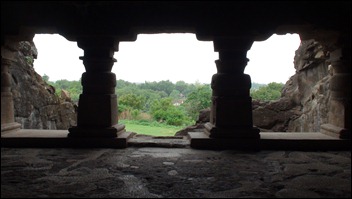 shina is entered by a door on each side of the shrine. The only sculptures on the walls inside are Mahishasuri on the south end of the front aisle and, Ganapati – four armed, on the north, both well preserved, from having been so long buried in the earth.
shina is entered by a door on each side of the shrine. The only sculptures on the walls inside are Mahishasuri on the south end of the front aisle and, Ganapati – four armed, on the north, both well preserved, from having been so long buried in the earth.
Cave 18 measures 67 feet by 55 over all. It has four clumsy unfinished columns in front, and a deep recess at each end inside. At the back of the hall is a vest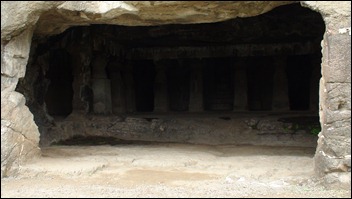 ibule or ante-chamber to the shrine 30 feet in length with two pillars and corresponding pilasters in front. Some plaster, consisting of mud with vegetable fiber in it, adheres to parts of the walls and pillars of this cave. On of the pillars, the last few letters of a painted inscription in Devanagari is still visible. In the shrine is a round pedestal set on a base, and of a different stone from the cave. In front, in the usual place for Nandi, is a square trough; possibly an agnikunda or fire-pit.
ibule or ante-chamber to the shrine 30 feet in length with two pillars and corresponding pilasters in front. Some plaster, consisting of mud with vegetable fiber in it, adheres to parts of the walls and pillars of this cave. On of the pillars, the last few letters of a painted inscription in Devanagari is still visible. In the shrine is a round pedestal set on a base, and of a different stone from the cave. In front, in the usual place for Nandi, is a square trough; possibly an agnikunda or fire-pit.
Descending to a slightly lower level, a little further, we come to the p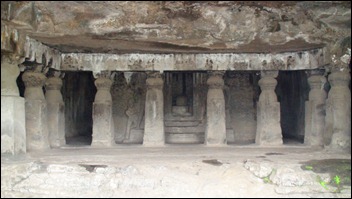 rimitive looking Cave 19. Part of the roof had fallen in and has been reconstructed and excavated completely. Earlier rain water used to stand in it but now it has been taken care of. The front pillars have gone and for some distance inside the entrance the cave is not so wide as it is in the middle, where four pillars on each side screen off the recess; in line with the fourth of these are four more in front of the shrine, which contains a broken pedestal and a linga. The pillars are very rude attempts at the Elephant style with cushion-shaped capitals. The dvarapalas of the shrine are of good height with minimum ornamentation and carry maces.
rimitive looking Cave 19. Part of the roof had fallen in and has been reconstructed and excavated completely. Earlier rain water used to stand in it but now it has been taken care of. The front pillars have gone and for some distance inside the entrance the cave is not so wide as it is in the middle, where four pillars on each side screen off the recess; in line with the fourth of these are four more in front of the shrine, which contains a broken pedestal and a linga. The pillars are very rude attempts at the Elephant style with cushion-shaped capitals. The dvarapalas of the shrine are of good height with minimum ornamentation and carry maces.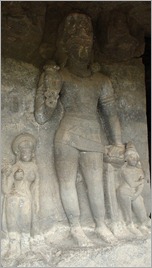
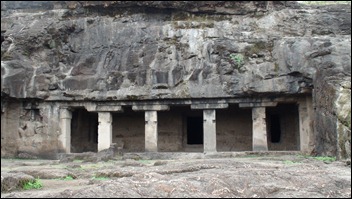 Ascending again, we come to Cave 20, a small linga shrine, originally with two pillars in front, now gone. Outside the facade on the north is Ganapati, and on the south is Mahishasuri. The shrine has a wide circumambulatory round it, and in each entrance to it is a large cell with two square pillars, having octagon necks in front. Inclusive of these chambers, the cave measures 53 feet by 30 overall. The shrine door is carved round with creeper and roll patterns. On each side is a tall dvarapala, with a small female figure between him and the entrance. On the platform outside is a square base, either of the victory pillar or the remains of a pedestal for a Nandi.
Ascending again, we come to Cave 20, a small linga shrine, originally with two pillars in front, now gone. Outside the facade on the north is Ganapati, and on the south is Mahishasuri. The shrine has a wide circumambulatory round it, and in each entrance to it is a large cell with two square pillars, having octagon necks in front. Inclusive of these chambers, the cave measures 53 feet by 30 overall. The shrine door is carved round with creeper and roll patterns. On each side is a tall dvarapala, with a small female figure between him and the entrance. On the platform outside is a square base, either of the victory pillar or the remains of a pedestal for a Nandi.
We now move on to one of the prominent Brahmanical caves, the Ramesvara.
